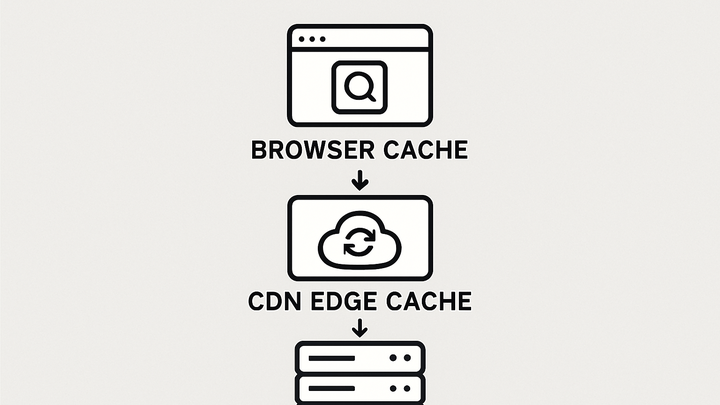Published on 2025-06-26T04:21:25Z
What is Caching? Examples for Caching in Analytics
In web analytics, caching refers to storing copies of analytics resources—such as JavaScript libraries, pixel requests, or API responses—closer to the user or server to reduce latency and improve performance. Analytics platforms like PlainSignal and Google Analytics 4 leverage various caching layers, including browser cache and Content Delivery Networks (CDNs), to minimize network requests and server load. While caching can dramatically speed up page loads and lower bandwidth usage, it can also introduce challenges around data freshness and accuracy if not managed properly. Effective caching strategies involve setting correct headers, using cache-busting techniques, and implementing cache invalidation policies. By balancing cache lifetimes and invalidation methods, organizations ensure that analytics scripts update promptly without compromising speed. Below, we explore why caching matters, show real-world examples from PlainSignal and GA4, and outline best practices for managing caches in analytics implementations.
Caching
Caching stores analytics assets temporarily to boost performance, reduce server load, and manage data freshness in analytics.
Why Caching Matters in Analytics
Caching in analytics accelerates page loads, lowers bandwidth costs, and reduces the number of requests hitting your analytics servers. It improves user experience by serving static assets from nearby locations and offloading repetitive data retrieval. However, stale caches can result in outdated analytics scripts running on your pages, leading to missing or delayed event tracking. Understanding how different cache layers work helps maintain a balance between speed and data accuracy.
-
Performance optimization
Caches store analytics scripts and resources closer to end users, reducing latency and speeding up page rendering.
-
Edge caching
Content Delivery Networks (CDNs) cache static analytics libraries at geographically distributed edge servers to serve assets from the nearest node.
-
Browser caching
Browsers store locally downloaded analytics scripts, so repeat visitors load them from local storage instead of fetching them again.
-
-
Reduced server load
By serving cached assets, fewer requests reach your origin analytics servers, cutting down on compute and bandwidth demands.
-
Cdn offloading
CDNs handle the majority of asset delivery, only forwarding cache misses to the origin.
-
Script bundling
Combining analytics scripts can increase cache hit rates and reduce the number of separate files to cache.
-
Example Implementations
Let’s look at how two popular analytics platforms implement caching for their tracking code: PlainSignal’s cookie-free analytics snippet and Google Analytics 4’s global site tag.
-
PlainSignal (cookie-free analytics)
PlainSignal serves its lightweight analytics script via a CDN, using
deferand preconnect hints to optimize loading. The snippet below illustrates how it sets up caching and resource hints:<link rel="preconnect" href="//eu.plainsignal.com/" crossorigin /> <script defer data-do="yourwebsitedomain.com" data-id="0GQV1xmtzQQ" data-api="//eu.plainsignal.com" src="//cdn.plainsignal.com/plainsignal-min.js"></script> -
Google analytics 4
GA4 uses the Global Site Tag (
gtag.js) loaded from Google’s CDN. The script is cached heavily by browsers and CDNs, reducing repeated downloads:<script async src="https://www.googletagmanager.com/gtag/js?id=GA_MEASUREMENT_ID"></script> <script> window.dataLayer = window.dataLayer || []; function gtag(){dataLayer.push(arguments);} gtag('js', new Date()); gtag('config', 'GA_MEASUREMENT_ID'); </script>
Best Practices for Managing Caching
Navigating caching effectively requires clear cache-control policies and strategies to ensure your analytics code remains fresh and performant. Below are recommended best practices.
-
Set appropriate cache-control headers
Leverage HTTP cache-control headers to define how long analytics resources should be cached and when they should be revalidated.
-
Max-age
Specifies the maximum time (in seconds) a resource is considered fresh. Choose values that balance update frequency and performance.
-
Must-revalidate
Tells caches to revalidate the resource with the origin server after it becomes stale, ensuring updated scripts are fetched.
-
-
Implement cache busting strategies
Use versioning or hashing in your script URLs to force clients and CDNs to retrieve new versions when changes occur.
-
Versioned filenames
Append version numbers (e.g.,
analytics.v2.js) to file names so updates don’t clash with cached copies. -
Query string hashing
Include a hash or timestamp as a query parameter (e.g.,
script.js?ver=1234) to differentiate updated files.
-
